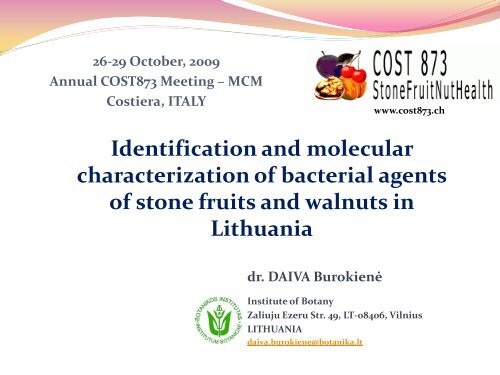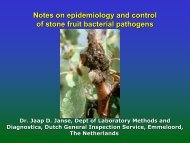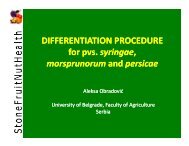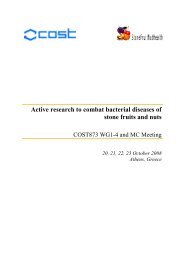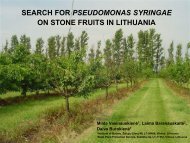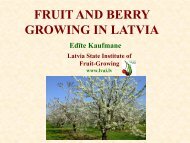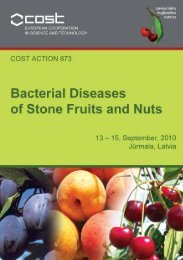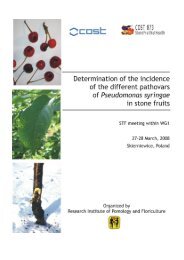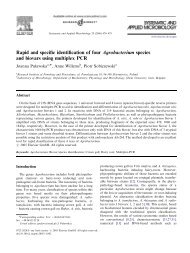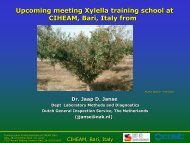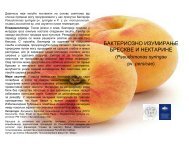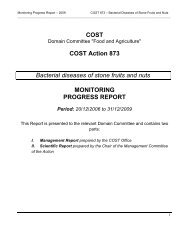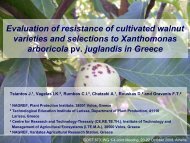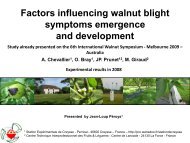Xanthomonas arboricola pv. juglandis - Cost 873
Xanthomonas arboricola pv. juglandis - Cost 873
Xanthomonas arboricola pv. juglandis - Cost 873
You also want an ePaper? Increase the reach of your titles
YUMPU automatically turns print PDFs into web optimized ePapers that Google loves.
26-29 October, 2009<br />
Annual COST<strong>873</strong> Meeting – MCM<br />
<strong>Cost</strong>iera, ITALY<br />
www.cost<strong>873</strong>.ch<br />
Identification and molecular<br />
characterization of bacterial agents<br />
of stone fruits and walnuts in<br />
Lithuania<br />
dr. DAIVA Burokienė<br />
Institute of Botany<br />
Zaliuju Ezeru Str. 49, LT-08406, Vilnius<br />
LITHUANIA<br />
daiva.burokiene@botanika.lt
Objective<br />
Distribution<br />
Identification<br />
Diversity<br />
of most harmful bacterial diseases<br />
and their causal agents<br />
on stone fruits and nuts
Crops of interest<br />
Stone fruits<br />
Cherry (sour, sweet)<br />
Plum, prune<br />
Apricot, pear<br />
Nuts<br />
Walnuts<br />
Huzelnut
EPPO Pest Lists<br />
EPPO List A1<br />
• Xylella fastidiosa<br />
EPPO List A2<br />
• Pseudomonas syringae <strong>pv</strong>. persicae<br />
• <strong>Xanthomonas</strong> <strong>arboricola</strong> <strong>pv</strong>. pruni<br />
• <strong>Xanthomonas</strong> <strong>arboricola</strong> <strong>pv</strong>. corylina
Bacterial pathogens<br />
Agrobacterium tumefaciens<br />
Brenneria nigrifluens<br />
Brenneria rubrifaciens<br />
Pseudomonas amygdali<br />
P. avellenae<br />
P. syringae <strong>pv</strong>. avii<br />
P. s. <strong>pv</strong>. castaneae<br />
P. s. <strong>pv</strong>. morsprunorum<br />
P. s. <strong>pv</strong>. syringae<br />
<strong>Xanthomonas</strong> <strong>arboricola</strong> <strong>pv</strong>. <strong>juglandis</strong>
Identification<br />
I. Walnuts<br />
<strong>Xanthomonas</strong> <strong>arboricola</strong> <strong>pv</strong>. <strong>juglandis</strong><br />
II.<br />
Sour cherry, sweet cherry, plum, prune<br />
Pseudomonas syringae <strong>pv</strong>. syringae<br />
P. syringae <strong>pv</strong>. morsprunorum race 1<br />
P. syringae <strong>pv</strong>. morsprunorum race 2
I. <strong>Xanthomonas</strong> <strong>arboricola</strong><br />
<strong>pv</strong>. <strong>juglandis</strong><br />
Walnut Blight<br />
Juglans cinerea L.<br />
J. mandshurica Maxim.<br />
J. regia L.<br />
J. nigra L.<br />
J. cordiformis (Maxim.) Rehder<br />
Two hybrids<br />
J. x bixbyi Rehd. (J. cinerea x J. ailantifolia)<br />
J. x quadrangulata (Carr.) Rehd. (J. cinerea x J. regia)
<strong>Xanthomonas</strong> <strong>arboricola</strong><br />
<strong>pv</strong>. <strong>juglandis</strong><br />
- disease symptoms<br />
- colonies on YDC medium<br />
- Gram-reaction<br />
- oxidase and catalase reaction<br />
- growth on potato slices<br />
59 <strong>Xanthomonas</strong>–like<br />
isolates were obtained
<strong>Xanthomonas</strong> <strong>arboricola</strong><br />
<strong>pv</strong>. <strong>juglandis</strong><br />
<strong>Xanthomonas</strong> genus specific primers<br />
X1 ir X2 (MAES, 1993)<br />
480 bp<br />
480 bp<br />
M – 100 bp marker (Ladder Plus)<br />
LMG746 – typical strain<br />
110AII, 113, 113A, 313, 314, 326, 327 ir 328 – isolates
<strong>Xanthomonas</strong> <strong>arboricola</strong><br />
<strong>pv</strong>. <strong>juglandis</strong><br />
growth at 35 ºC<br />
esculin hydrolysis<br />
soluble starch hydrolysis<br />
mucoid growth on YDC and SQ media<br />
hypersensitivity reaction on tobacco leaves
<strong>Xanthomonas</strong> <strong>arboricola</strong><br />
<strong>pv</strong>. <strong>juglandis</strong><br />
specific primers<br />
(TRAINING COURSE, Angers, France)<br />
X Xaj M Xaj K+ K-<br />
X – <strong>Xanthomonas</strong><br />
Xaj – isolates<br />
M – 100 bp marker (Ladder Plus)<br />
K+ – positive control (typical strains)<br />
K- – negative control
Genetic diversity<br />
(rep-PGR)<br />
• Primers – Versalovic et al. al.(1991)<br />
• Conditions – Scortichini et al. (2001)<br />
REP primers<br />
M – marker; XO4, LMG746 – typical strains;<br />
313, 314, 326, 327 and 328 – Lithuanian strains
Bark canker of walnuts?
II. Pseudomonas syringae<br />
Bacterial canker<br />
sweet cherry<br />
sour cherry<br />
plum
Bacterial canker<br />
trunks
Bacterial canker<br />
twigs<br />
shoots
Bacterial canker<br />
blossoms<br />
leaves<br />
buds
Identification of<br />
Pseudomonas syringae pathovars<br />
77 P. syringae-like isolates were tested:<br />
LOPAT, GATTa, lactic acid<br />
(LELLIOTT, STEAD, 1987; SHAAD et al., 2001)<br />
PCR for:<br />
coronatine (primers cfl1 and cfl2);<br />
yersiniabactin (primers PSYE2 and PSYE2R);<br />
syringomycin (primers syrB1 and syrB2).
21 isolate was identified as<br />
Pseudomonas syringae,<br />
where:<br />
Pss – 14 strains;<br />
Psm (race 1) – 4 strains;<br />
Psm (race 2) – 3 strains.
Genetic diversity<br />
Pseudomonas syringae <strong>pv</strong>. syringae<br />
PCR MP<br />
(PCR melting profile)<br />
M – 100 bp marker<br />
LMG1247 – typical strain<br />
K negative – negative control<br />
L1–L10 – Lithuanian strains<br />
LMG1247<br />
L1<br />
L2<br />
L3<br />
L4<br />
L5<br />
L6<br />
L7<br />
L8<br />
L9<br />
L10<br />
M<br />
K negative
Short-Term Scientific Mission<br />
19/03-07/04/2009<br />
“Molecular identification and<br />
characterization of phytopathogenic<br />
bacteria using PCR techniques”<br />
prof. habil. dr. Piotr Sobiczewski<br />
dr. Joanna Puławska<br />
RESEARCH INSTITUTE OF POMOLOGY and FLORICULTURE<br />
Department of Phytopathology<br />
Laboratory of Bacteriology<br />
Skierniewice, POLAND
Ačiū už dėmesį!


